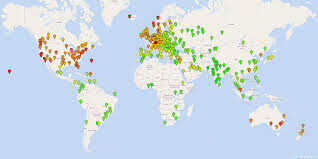The 2025 Global Cost of Living Index, utilizing the extensive database from Numbeo, delivers a comprehensive view of daily expenses and rent across more than 140 countries worldwide. By gauging each nation’s prices against New York City, which serves as the standard with a baseline score of 100, the index allows for meaningful international cost comparisons. Countries with scores near 100 are nearly as expensive as New York, while those with significantly lower numbers indicate a much more affordable way of life.
What the Index Measures
The Cost of Living & Rent Index captures both routine day-to-day expenses and the costs of housing. This dual focus provides a more complete picture of actual affordability in different parts of the world. The 2025 edition ranks the Cayman Islands as the most expensive country, with an index score of 94.3. Not far behind are Switzerland and Singapore, long recognized for their strong economies, high wages, and premium real estate sectors. At the other end of the spectrum, South Asian countries like Pakistan, India, and Bangladesh report the lowest costs, with overall prices about one-eighth of those in New York.
The World’s Most Expensive Countries
At the top of the cost rankings sit established wealth hubs. The Cayman Islands lead, followed by Switzerland and Singapore. These nations have developed reputations for their high living standards, strong financial sectors, and lucrative real estate markets. Several European countries also appear in the top 20, such as Iceland, Ireland, and Norway—places known for their high quality of life, which often comes at the expense of higher daily costs. The United States ranks twelfth, showing that while life there is costly, several smaller nations surpass it.
The World’s Most Affordable Nations
In contrast, countries with much lower costs are mainly clustered in South Asia and parts of Africa. Here, daily life and housing are far less expensive compared to global averages. Pakistan and Libya share the lowest index (11.3 each), with Afghanistan, India, and Bangladesh only slightly higher. Affordability in these countries is shaped by relatively low wage levels and large, young populations, which help keep the price of goods, services, and rent minimal.
Regional Patterns Among Countries
The index reveals clear regional trends. European and North American countries consistently feature among the most expensive, while many African, Asian, and South American nations fall onto the more affordable side. Wealthier countries tend to offer extensive public services and high wages, which elevate overall prices. Meanwhile, countries with more modest economic circumstances continue to provide the most budget-friendly options for both residents and expatriates.
How Index Scores Translate
Every country receives a score relative to New York City. For example, an index of 80 means the cost of living—and rent—is 20% less there than in New York. Conversely, a low score like 12 indicates prices are extremely affordable in comparison, representing savings of nearly 88% on daily expenses and housing. Such a wide range of scores provides valuable guidance for those considering international moves, investments, or travel.
Gathering Data for the Index
Numbeo’s index is built from the input of thousands of contributors worldwide who report real prices for groceries, dining, transportation, utilities, and accommodation. This data-driven methodology ensures robust and up-to-date cost comparisons and makes the index a respected resource for financial planning and international benchmarking.
Key Highlights for 2025
This year’s ranking continues familiar trends: global financial hubs remain expensive due to their advanced economic structures and appeal to wealthy residents and investors. Meanwhile, affordability remains concentrated in countries with lower general incomes and less developed consumer markets. These divergent trends highlight how economic development and demographic factors shape the price of everyday life around the world.
The Value of Understanding Cost of Living
The Cost of Living Index serves as a practical tool for various audiences, from travelers and expatriates to investors and researchers. It helps to highlight global disparities and similarities, making information on international affordability transparent and actionable. By comparing housing, goods, and services, the index empowers decision-makers to find destinations that fit their budgets and lifestyles.










